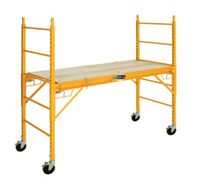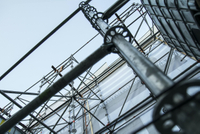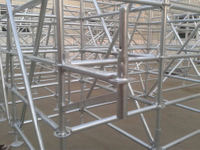Content Menu
● Introduction
● What Is Ladder Frame Scaffolding?
● Key Safety Advantages of Ladder Frame Scaffolding
>> 1. Stable Working Platform
>> 2. Integrated Access
>> 3. Guardrails and Toeboards
>> 4. Load-Bearing Capacity
>> 5. Versatility and Adaptability
● Comparison: Ladder Frame Scaffolding vs. Traditional Ladders
● Essential Safety Features and Best Practices
>> 1. Proper Assembly and Inspection
>> 2. Load Management
>> 3. Fall Protection
>> 4. Safe Access and Egress
>> 5. Regular Maintenance
>> 6. Environmental Awareness
● Enhancing Worker Productivity and Safety Culture
● Conclusion
● FAQ
>> 1. What are the main safety features of ladder frame scaffolding?
>> 2. How often should ladder frame scaffolding be inspected?
>> 3. Can ladder frame scaffolding be used on uneven ground?
>> 4. What is the maximum spacing for ladder rungs on scaffold frames?
>> 5. Is ladder frame scaffolding suitable for all types of construction projects?
Ladder frame scaffolding is a cornerstone of modern construction safety, offering a robust, versatile, and efficient platform for working at height. Its unique design not only provides stable access but also integrates safety features that significantly reduce the risks associated with elevated work. This comprehensive guide explores how ladder frame scaffolding enhances safety on construction sites, compares it to traditional ladders, and answers common questions with detailed explanations.
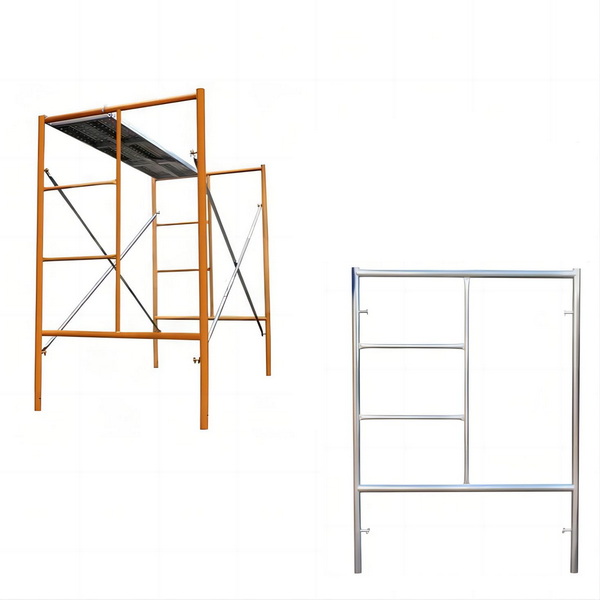
Introduction
Construction sites are inherently hazardous environments, especially when work must be performed at height. Falls remain one of the leading causes of injuries and fatalities in the industry. Ladder frame scaffolding has emerged as a preferred solution, offering a safer alternative to traditional ladders and other access systems by combining stability, accessibility, and integrated safety features.
What Is Ladder Frame Scaffolding?
Ladder frame scaffolding is a type of frame scaffolding system distinguished by its built-in ladder rungs, which are integrated into the vertical frames. This design allows workers to ascend and descend safely between scaffold levels without the need for separate ladders or risky climbing practices.
Types of Ladder Frame Scaffolding:
- Single Ladder Frame: Features one set of ladder rungs on one side.
- Double Ladder Frame: Rungs on both sides for enhanced access.
- Walk-Through Ladder Frame: Combines a walk-through section with an integrated ladder for easy movement and access.
Applications:
- Masonry work
- Stucco and plastering
- General building construction
- Industrial maintenance
Key Safety Advantages of Ladder Frame Scaffolding
1. Stable Working Platform
Ladder frame scaffolding provides a broad, stable platform for workers, tools, and materials. This reduces the risk of falls compared to narrow ladders, especially during tasks that require movement or handling of heavy objects.
2. Integrated Access
The built-in ladder rungs offer safe, direct access to each level of the scaffold. This eliminates the need for makeshift ladder solutions, which can be unstable or improperly secured.
3. Guardrails and Toeboards
Modern ladder frame scaffolding systems are equipped with guardrails, mid-rails, and toeboards, which prevent accidental falls and stop tools or materials from dropping off the platform.
4. Load-Bearing Capacity
Ladder frame scaffolding is engineered to support significant weight, often four times the intended load, accommodating multiple workers and their equipment safely.
5. Versatility and Adaptability
These scaffolds can be quickly assembled, adjusted, and moved as needed, making them suitable for a wide range of construction scenarios, from residential renovations to complex industrial projects.
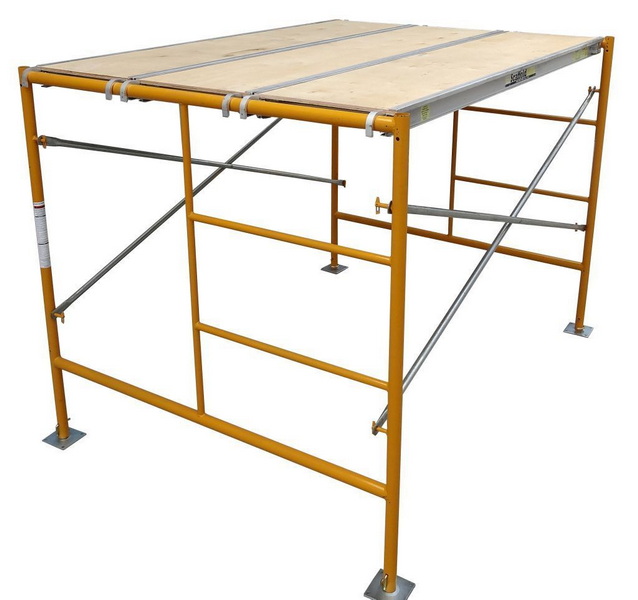
Comparison: Ladder Frame Scaffolding vs. Traditional Ladders
| Feature | Ladder Frame Scaffolding | Traditional Ladder |
| Stability | High (broad base, secure frame) | Low (narrow base, prone to tipping) |
| Working Platform | Wide, allows free movement | Narrow, limited movement |
| Guardrails/Toeboards | Yes | No |
| Load Capacity | High (multiple workers/tools) | Low (one worker, limited tools) |
| Integrated Access | Built-in ladder rungs | Separate ladder required |
| Fall Protection | Guardrails, harness points | None |
| Versatility | Modular, adaptable | Fixed, limited adaptability |
| Assembly Time | Quick (modular) | Minimal, but less safe |
| Compliance | Meets OSHA/ANSI standards | Often does not |
Essential Safety Features and Best Practices
1. Proper Assembly and Inspection
- Always follow manufacturer instructions for assembly.
- Inspect frames for structural integrity, alignment, and damage before each use.
- Secure all locking pins, braces, and planks.
2. Load Management
- Never exceed the rated load capacity.
- Distribute weight evenly across the platform.
3. Fall Protection
- Install guardrails, mid-rails, and toeboards on all open sides.
- Use personal fall arrest systems (PFAS) when required, especially above 10 feet.
4. Safe Access and Egress
- Use only the built-in ladder rungs or approved access points.
- Maintain three points of contact when climbing.
5. Regular Maintenance
- Clean and lubricate moving parts.
- Replace damaged or worn components immediately.
6. Environmental Awareness
- Avoid use during high winds, rain, or on unstable ground.
- Use adjustable base plates or leg extensions for uneven surfaces.
Enhancing Worker Productivity and Safety Culture
Beyond the direct safety benefits, ladder frame scaffolding also contributes significantly to improving worker productivity and fostering a strong safety culture on construction sites. By providing a reliable and secure platform, workers can focus more on their tasks without the distraction or fear of potential falls or accidents. This increased confidence often leads to higher efficiency and better quality workmanship. Moreover, the presence of well-maintained ladder frame scaffolding signals a commitment to safety from management, encouraging workers to adhere to safety protocols and report hazards promptly. This proactive approach to safety helps reduce incidents and promotes a collaborative environment where safety is everyone's responsibility.
Conclusion
Ladder frame scaffolding represents a significant advancement in construction safety, combining stability, accessibility, and comprehensive fall protection in a modular system. Its integrated ladder rungs, robust platforms, and safety features such as guardrails and toeboards make it far superior to traditional ladders for elevated work. Proper assembly, regular inspection, and adherence to safety protocols are essential to maximize its benefits and minimize risks. By investing in ladder frame scaffolding and following best practices, construction sites can dramatically reduce accidents and create a safer working environment for all.
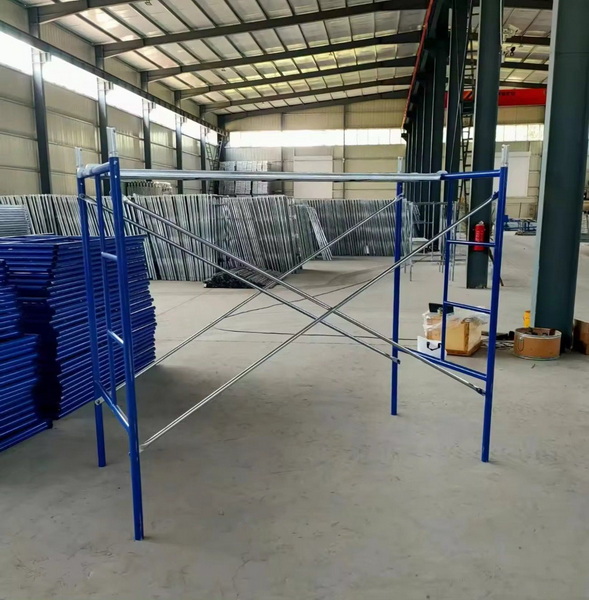
FAQ
1. What are the main safety features of ladder frame scaffolding?
Ladder frame scaffolding includes integrated ladder rungs for safe access, wide platforms for stable working conditions, guardrails, mid-rails, and toeboards for fall protection, and secure locking mechanisms to prevent accidental disassembly.
2. How often should ladder frame scaffolding be inspected?
Scaffolding should be inspected before each work shift and after any event that could affect its structural integrity, such as being dropped or exposed to harsh conditions. Regular inspections help identify potential hazards and ensure compliance with OSHA regulations.
3. Can ladder frame scaffolding be used on uneven ground?
Yes, but it must be properly leveled using adjustable base plates or screw jacks. Never use unstable objects like bricks or boxes to support scaffolding, as this compromises stability and safety.
4. What is the maximum spacing for ladder rungs on scaffold frames?
OSHA standards require that ladder rungs on scaffold frames be uniformly spaced, with a maximum spacing of 16 ¾ inches. Rungs must also be at least 8 inches long and provide sufficient clearance for hands and feet.
5. Is ladder frame scaffolding suitable for all types of construction projects?
Ladder frame scaffolding is highly versatile and can be adapted for residential, commercial, and industrial projects. Its modular design allows it to be configured for various heights and complexities, making it suitable for most construction scenarios.













